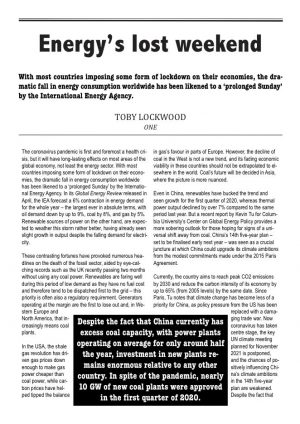 The coronavirus pandemic is first and foremost a health crisis, but it will have long-lasting effects on most areas of the global economy, not least the energy sector. With most countries imposing some form of lockdown on their economies, the dramatic fall in energy consumption worldwide has been likened to a ‘prolonged Sunday’ by the International Energy Agency. In its Global Energy Review released in April, the IEA forecast a 6% contraction in energy demand for the whole year – the largest ever in absolute terms, with oil demand down by up to 9%, coal by 8%, and gas by 5%. Renewable sources of power on the other hand, are expected to weather this storm rather better, having already seen slight growth in output despite the falling demand for electricity.
The coronavirus pandemic is first and foremost a health crisis, but it will have long-lasting effects on most areas of the global economy, not least the energy sector. With most countries imposing some form of lockdown on their economies, the dramatic fall in energy consumption worldwide has been likened to a ‘prolonged Sunday’ by the International Energy Agency. In its Global Energy Review released in April, the IEA forecast a 6% contraction in energy demand for the whole year – the largest ever in absolute terms, with oil demand down by up to 9%, coal by 8%, and gas by 5%. Renewable sources of power on the other hand, are expected to weather this storm rather better, having already seen slight growth in output despite the falling demand for electricity.
These contrasting fortunes have provoked numerous headlines on the death of the fossil sector, aided by eye-catching records such as the UK recently passing two months without using any coal power. Renewables are faring well during this period of low demand as they have no fuel cost and therefore tend to be dispatched first to the grid – this priority is often also a regulatory requirement. Generators operating at the margin are the first to lose out and, in Western Europe and North America, that increasingly means coal plants.
In the USA, the shale gas revolution has driven gas prices down enough to make gas power cheaper than coal power, while carbon prices have helped tipped the balance in gas’s favour in parts of Europe. However, the decline of coal in the West is not a new trend, and its fading economic viability in these countries should not be extrapolated to elsewhere in the world. Coal’s future will be decided in Asia, where the picture is more nuanced.
Even in China, renewables have bucked the trend and seen growth for the first quarter of 2020, whereas thermal power output declined by over 7% compared to the same period last year. But a recent report by Kevin Tu for Columbia University’s Center on Global Energy Policy provides a more sobering outlook for those hoping for signs of a universal shift away from coal. China’s 14th five-year plan – set to be finalised early next year – was seen as a crucial juncture at which China could upgrade its climate ambitions from the modest commitments made under the 2015 Paris Agreement.
Currently, the country aims to reach peak CO2 emissions by 2030 and reduce the carbon intensity of its economy by up to 65% (from 2005 levels) by the same date. Since Paris, Tu notes that climate change has become less of a priority for China, as policy pressure from the US has been replaced with a damaging trade war. Now coronavirus has taken centre stage, the key UN climate meeting planned for November 2021 is postponed, and the chances of positively influencing China’s climate ambitions in the 14th five-year plan are weakened.
Despite the fact that China currently has excess coal capacity, with power plants operating on average for only around half the year, investment in new plants remains enormous relative to any other country. The 13th five-year plan placed a 1100 GW cap on total coal capacity, but there are calls in the industry to raise this to 1300 GW for 2030 and, in spite of the pandemic, nearly 10 GW of new coal plants were approved in the first quarter of 2020. In the report, Tu suggests that China could increasingly turn to its own abundant and affordable coal as the government seeks to stimulate an economic recovery while entrenching its stance on energy independence.
The latest frontier for coal power is in South-East Asia, where many countries have bold plans for coal power expansion; here too, there is little indication that the pandemic will bring about a U-turn.
Most of these economies are more fragile than China’s, and leaders may be even more likely to see coal power projects – particularly where linked to domestic mining – as a less risky economic boost than an acceleration in the green transition.
On the other hand, several countries across the region had already started delaying overly ambitious power expansion plans in the face of looming overcapacity, largely due to overestimating demand growth. In the face of a global recession, that trend is likely to continue, but may hit power projects of all stripes.
How governments plan to spend their way out of the inevitable coronavirus recession is undoubtedly the critical issue for climate change mitigation worldwide. While the global financial crisis of 2007 saw some bright spots for renewables in stimulus packages, it is widely regarded as having set back investment in clean energy as many governments shifted priorities, reined in spending, and carbon prices collapsed.
This new crisis may well see a renewed determination to redesign the economy on low-carbon principles in developed economies, but it is much less certain that emerging economies will take the same pathway. After our enforced ‘Sunday’, will it be business-as-usual on Monday?
Toby Lockwood





